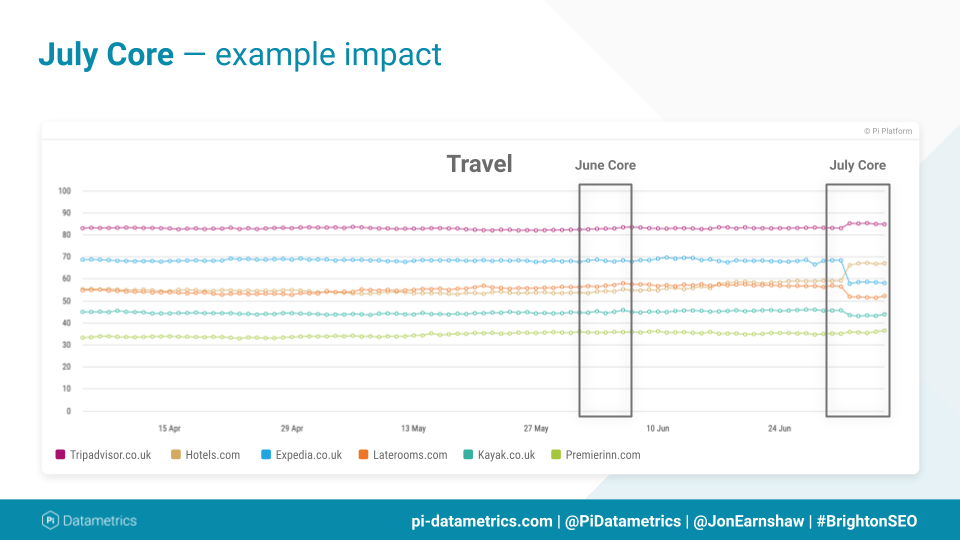How to survive Google’s 2021 updates
22 Jul 2021|5 MIN READ
It’s July, and we’ve now had three Google Core Updates so far this year, along with the introduction of Core Web Vitals.
Naturally, the prospect of turmoil in the SERPs can cause some stress amongst marketers, but we can help you to make sense of updates, and deal with any negative effects.
In Jon Earnshaw’s presentation from BrightonSEO, he looks at Google Algorithm updates and some key effects.
He looks at the core updates we’ve seen over the past year or so, with a close look at the July Google Core update, and what to expect for the rest of 2021.
Watch the recording
Core updates: a recent history
First of all, it’s important to clarify the difference between Broad Core updates, and core web vitals.
Core updates are pre-announced by Google, and generally happen around three times every year. They are concerned with expertise, authority and trust, or EAT.
Core Web Vitals, currently rolling out, is all about page experience, and is separate from regular updates.
Back to 2019, we saw three huge updates, which were upsetting for many websites, and focused on YMYL websites.
YMYL (Your Money or Your Life) refers to sites which potentially impact a person’s health, safety or financial security. Examples include sites offering financial or medical advice and, for obvious reasons, a certain level of authority and expertise is needed for such content.
The visibility index below shows five different websites, with 2,000 YMYL terms tracked, and can see the huge impact, with recovery slow for affected sites.
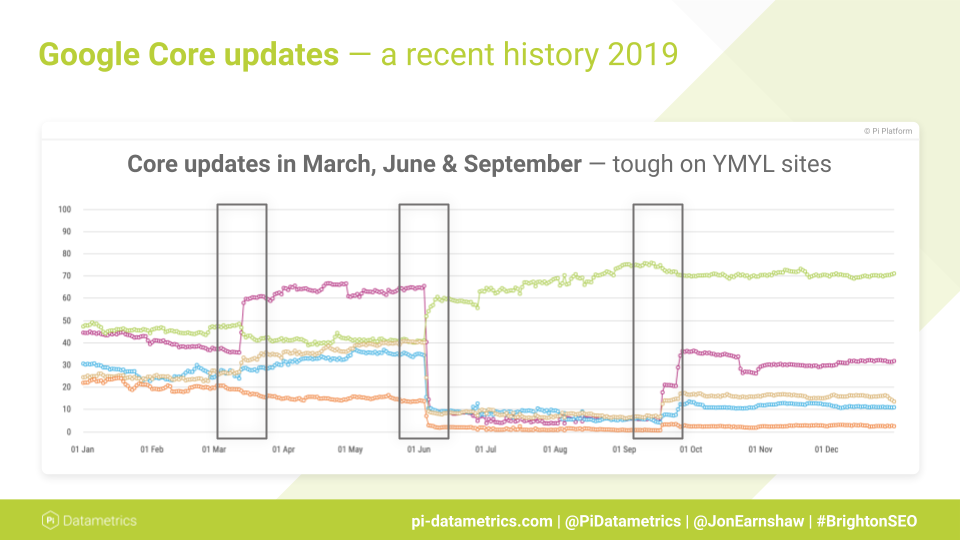
Image source: Pi’s SEO Platform
The May 4th core update was especially brutal for finance sites. This index shows creditkarma.com, which saw huge impacts on some high-volume search terms.
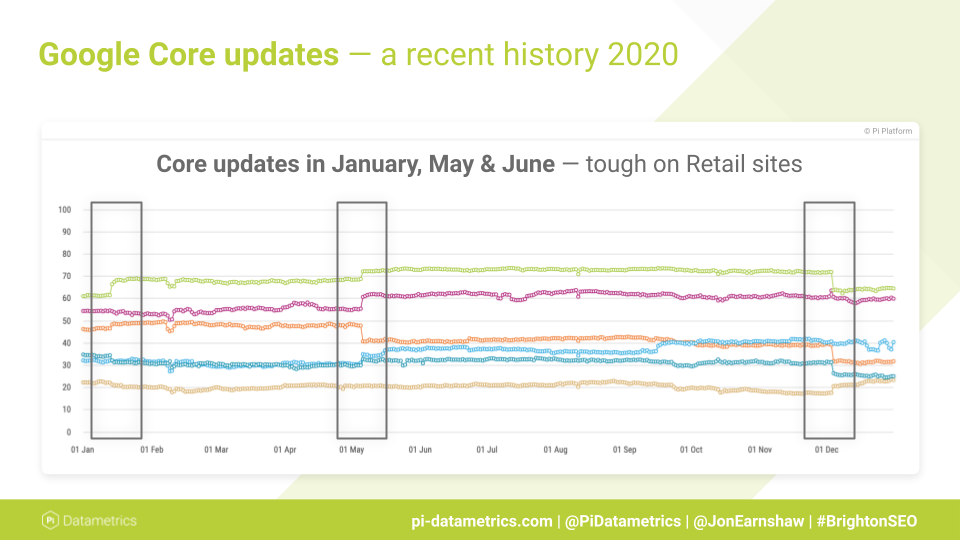
Image source: Pi’s SEO Platform
The May 4th core update was especially brutal for finance sites. This index shows creditkarma.com, which saw huge impacts on some high-volume search terms.

Image source: Pi’s SEO Platform
Looking at the content on the site, it’s hard to find much information about who was writing it, or the expertise which qualified them to write on such matters. Most was credited to ‘Credit Karma Staff’.
This makes you wonder if it’s just been written just to reel visitors in and, looking at reviews, we see are generally negative, especially compared to competitors. This is EAT in action.
So from the last couple of years, we expect more or less regularly spaced updates, little prospect of recovery between them, and previous updates have impacted the SERPs at scale, especially for YMYL sites.
2021’s Google algorithm updates
This visualisation shows the algorithm updates so far this year. We’ve created a meteor score to rate them according to the impact.
So, the first four updates had a relatively low impact. The Product Review update was specifically targeted at review sites, and generally resulted in a shifting of positions on page one.
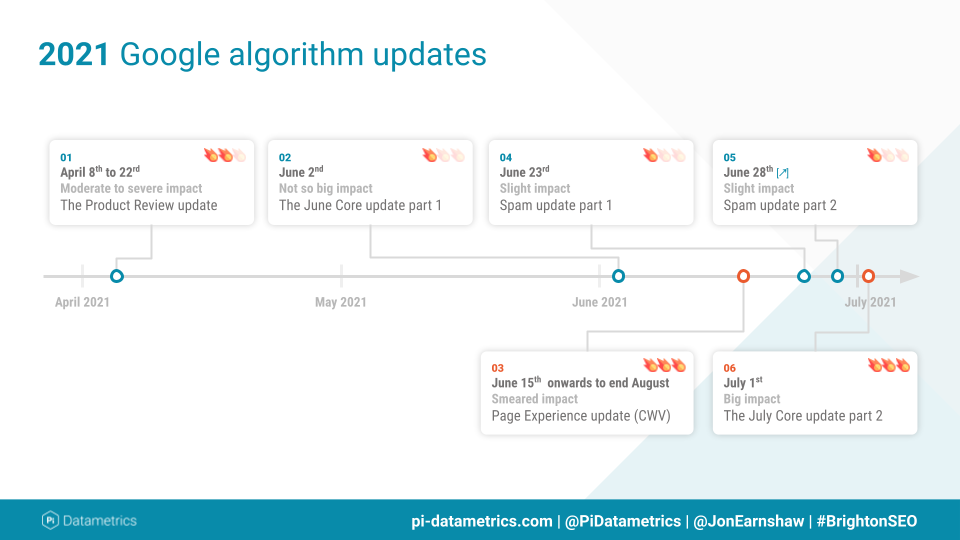
However, the Page Experience Update (Core Web Vitals), which began on June 15 is potentially hazardous for some sites, because of the way it has rolled.
If your page experience scores are ‘poor’ (red) or even ‘need improvement’ (amber) compared to your competitors, the day to day effects may seem small, but when you look back after the end of August when the rollout is complete, the impact may have been very significant.

Then comes the July Core Update, or part two of the June Core Update. This was a big shake up in visibility, which played out mainly on page one of the SERPs.
These were the sectors in which we saw some significant impact:
- Travel
- Fashion
- Electricals
- Automotive
- Gifts
- Online dating
- Investments
Here’s an example of the impact in the Travel sector on some of the major players. This index shows terms related to holidays in the UK, a key group of terms right now.
The Impact of the July 2021 Core Update
July 2021 Core Update – Example impact
Image source: Pi’s SEO Platform
So TripAdvisor had some uplift and Hotels.com moved onto page one for many terms. All were impacted, with Expedia experiencing the most significant drops.
Looking at Expedia, we see the changes happening on July 2, after a long period of stability.
Pages from high on page one moved further down page one, sometimes to page two. We see this same pattern across the board.
July 2021 Core Update – Example impact
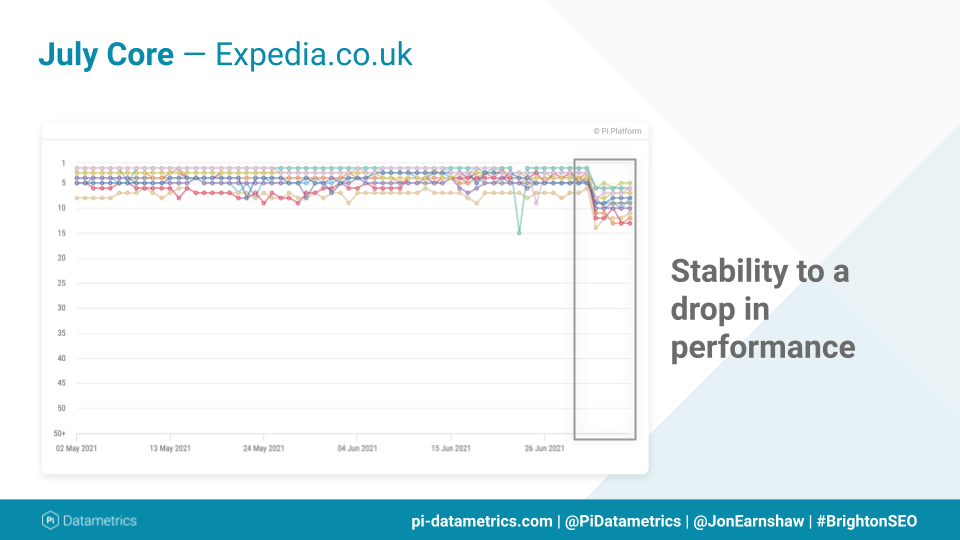
Image source: Pi’s SEO Platform
Looking at fashion, these competitor discovery charts, we see some activity in the top ten, with 23% increase in above the fold visibility for Next, while others fell slightly, with Missguided dropping out of the top 10.
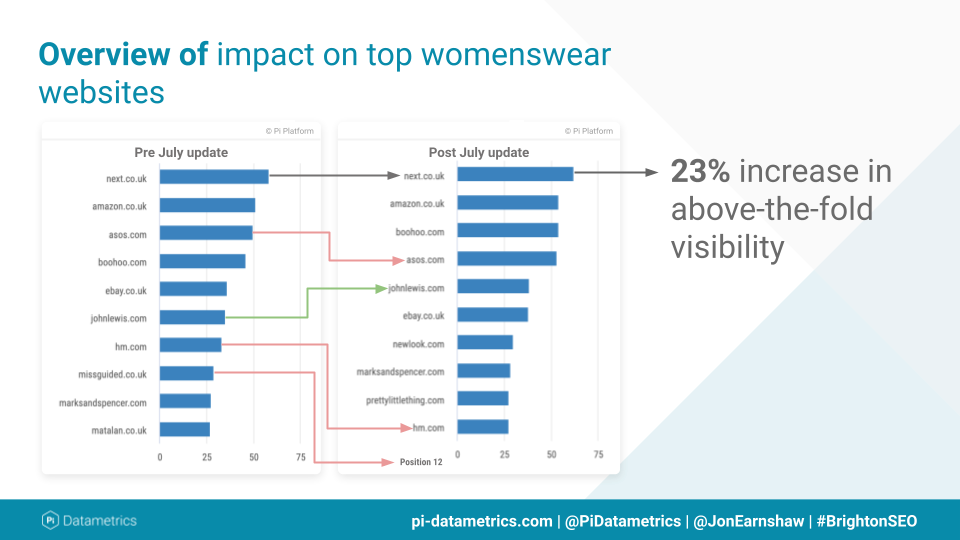
Image source: Pi’s SEO Platform
Fashion sites, shown over time, can go up and down, and recover from previous algorithm hits. Boohoo and prettylittlething dropped in April but recovered and increased its visibility in June / July.
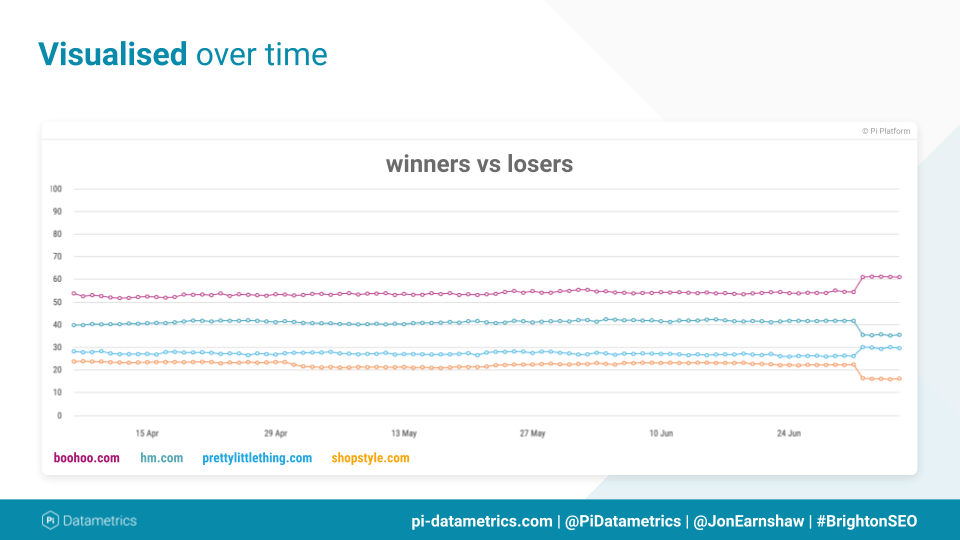
Image source: Pi’s SEO Platform
While you can’t recover from the Core Update, there are things you can do to improve performance. Core updates are about quality, so a focus on EAT signals will always help.
How to identify algorithm impacts
One key question is whether a drop in traffic and visibility is a result of an algorithm update, or is it self-inflicted.
Here’s an example from a UK department store, which experienced drops in search visibility across the board around late January this year.

Image source: Pi’s SEO Platform
One of the first questions people will ask is, was this the result of an update or is it just me? Well, the simple answer is to compare your site with you competitors.
In this case, we can see steady performance from major competitors, so it’s important to take a look at your content, and how you can improve.
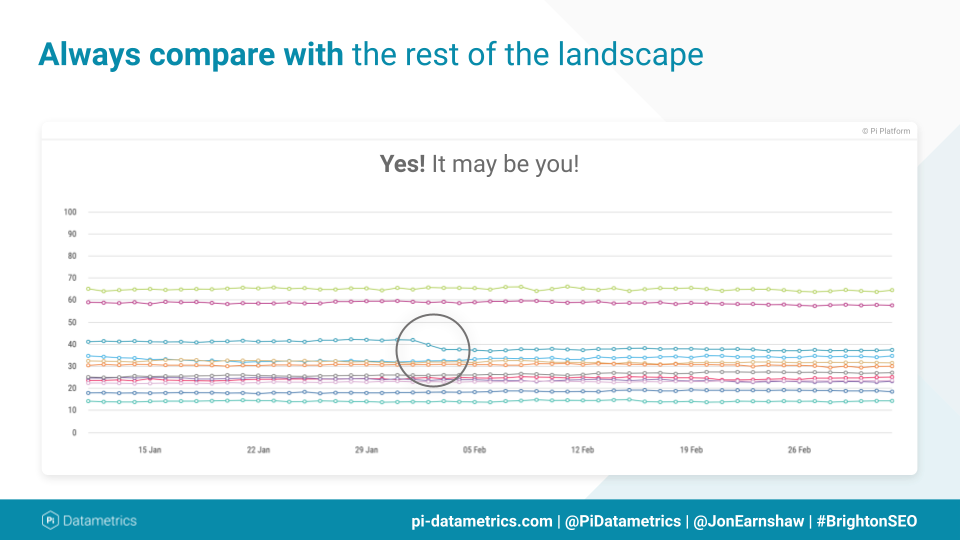
Image source: Pi’s SEO Platform
Here’s another example, for the BBC Good Food website. This chart shows what seems to be a drop in visibility across 2,000 recipe search terms on July 3rd.
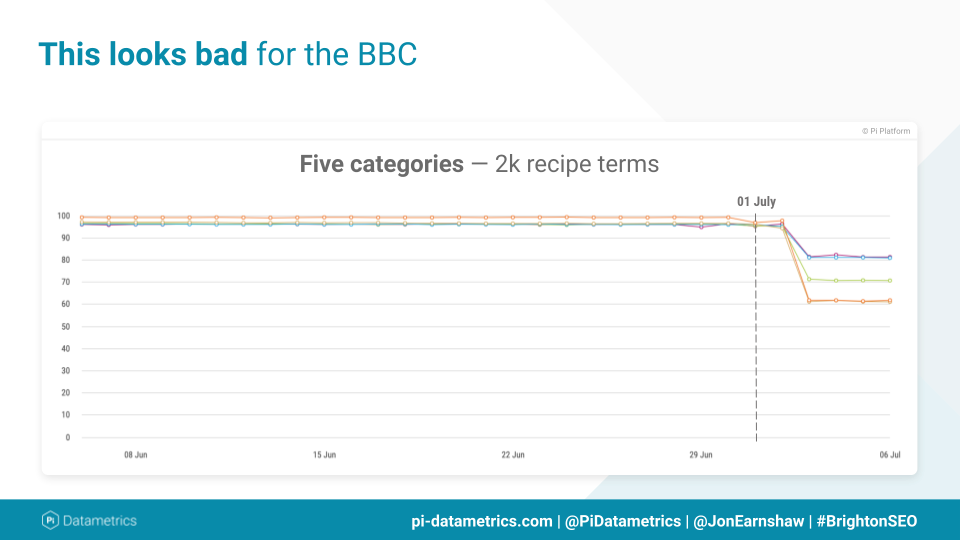
Image source: Pi’s SEO Platform
When we separate mobile from desktop, we see that mobile visibility remains stable, while desktop drops.
This tells you that this isn’t the result of an algorithm change, as both would have dropped if this was the case.
This is where it’s important to keep SERP features in mind, especially in topic areas where these features are common.
So, with feature positions included, we can see that visibility remains stable.
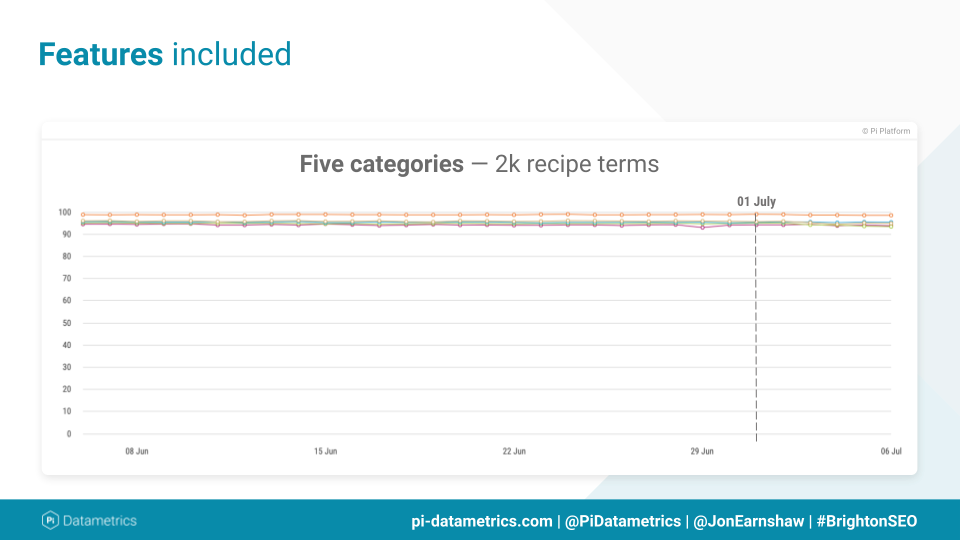
Image source: Pi’s SEO Platform
Looking at the SERPs, we can see what’s happening. The site is there on page one, but not always with a classic organic link.
Google seems to switch between showing classic links and recipe cards, while always keeping at least one type of result there.
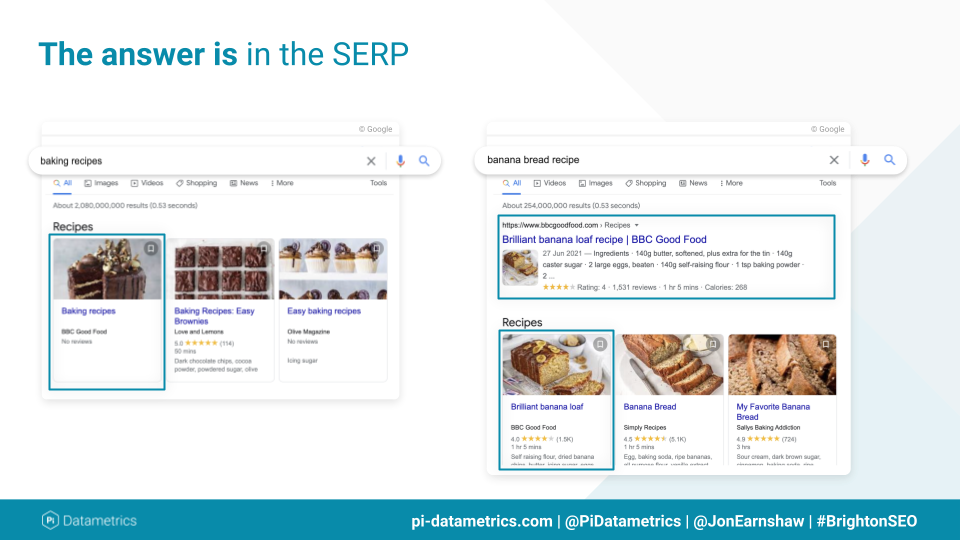
What can we expect for the rest of 2021?
Well, we already know that Core Web Vitals will continue to affect search visibility for many sites until the end of August.
There’s also likely to be another broad Core Update before the end of the year.
There are two key areas to focus on as a result of this:
- Core Web Vitals. Use the CWV report in Search Console to identify issues, get into the details with Lighthouse, and work on improvements. Don’t wait till the end of August, get started now.
- EAT. Working on Google EAT is the best way to future-proof your site from future updates, and increase performance in the short-term. Don’t wait for the update, anticipate it and work towards improving performance.
Demo the software today
Never miss a post
Join our mailing list and have our SEO news delivered straight to your inbox.
Never miss a post
Join our mailing list and have our SEO news delivered straight to your inbox.
